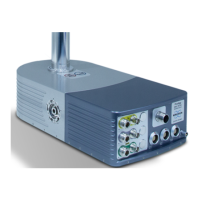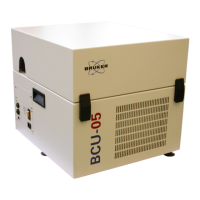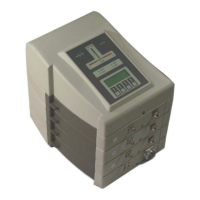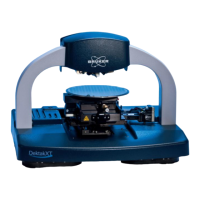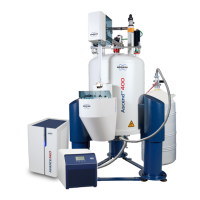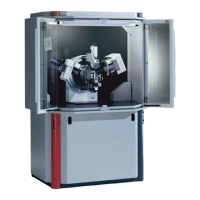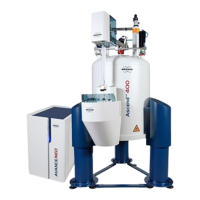84 (107) BRUKER CryoProbe User Manual
Troubleshooting
Lock unstable
Any fluctuations in the pneumatic gas or the VT gas supplies can directly affect
the lock level. When using nitrogen, any even minute leaks in the VT gas lines will
cause a mixing of nitrogen and air. Due to the paramagnetic susceptibility of air
(due to its oxygen content), fluctuation in the shimming and consequently in the
lock level will result.
Temperature gradients in the sample can also cause lock level instabilities, in par-
ticular with acetone-d
6
lock solvent, if they are large enough to affect the line-
shape of the lock signal and thereby its maximum intensity. Thus, a sufficient flow
of VT gas is mandatory to provide a homogeneous temperature across the sam-
ple. Obey the minimum gas flow rate specified on the L
IMITATIONS - WARNINGS
sheet.
On the other hand, the lock level is quite sensitive to the VT gas flow rate, in par-
ticular if a blue plastic spinner is used. (Blue spinners are not recommended be-
cause they are light, white plastic spinners are preferred.) Usually, a VT gas flow
rate of ≥ 600
/h is specified on the LIMITATIONS - WARNINGS sheet but 800 /h may
already lift the sample, resulting in an unstable lock level.
Spurious signals 7.7.3
All RF filters needed for the CryoProbe are already built-in. Do not use extra fil-
ters. If it looks as if extra RF filters would be needed to improve the situation, con-
tact B
RUKER.
Background signals
Background signals are NMR signals of substances that are located somewhere
close to the cavity or any part of a tuned probe circuit. Cryogenically cooled
probes are more prone to background signals for two reasons: (1) the high signal-
to-noise ratio of the receiving system enhances the background by the same fac-
tor as the desired signals; (2) the nuclear magnetization of any material increases
in proportion to (Curie law) which results in a considerably stronger NMR re-
sponse from substances located in the cold parts of the resonant circuit.
Consequently, a background virtually cannot be avoided and is usually much larg-
er than for conventional probes. However, it can be removed in most cases by a
simple baseline correction (e.g. abs).
Sharp background signals, however, should not be present. Clean the sample
cavity with a special procedure (see "Cleaning" on page 67
).
Vibration sidebands
If there are vibration sidebands in the spectrum (which are absent in a reference
spectrum taken with a conventional probe),
1. check the lock regulation parameters,
2. verify the proper attachment of the He Transferline to the Transferline
Support,
3. check if the CryoProbe is tightly fixed to the magnet,
4. check the proper operation of the magnet anti-vibration dampers.
CAUTION: Before lifting the magnet, make sure that nothing will ob-
struct the vertical movement of the CryoProbe. In particular: if cranked
1T⁄
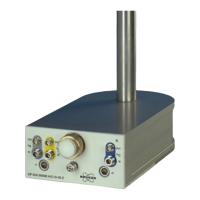
